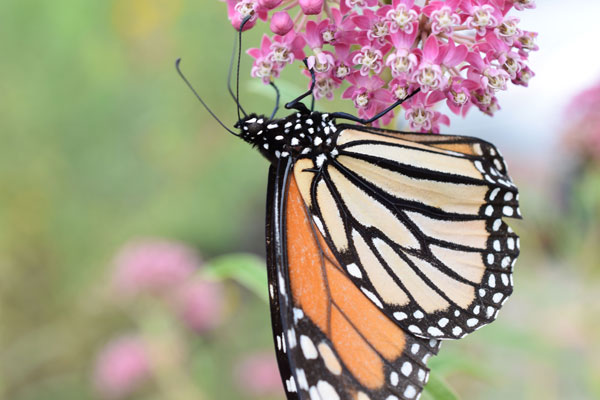It is garden season, and I had an experience last fall that helped me decide that I want to work on being a responsible gardener. The longer I have the opportunity working for the Soil and Water Conservation District, the greater my appreciation is for the work done here. Last fall, I had the opportunity to visit a large pollinator garden that the district was involved in starting. The insect activity and beauty of this garden was wonderful. I saw insects that I didn’t even know existed. We were there that day to catch Monarch butterflies to tag for a program that is monitoring the Monarch migration pattern. I must say, I never stop learning here.
I’m sure everyone knows about mimicry. Well, I didn’t until the visit to the pollinator garden that day. There is a butterfly that mimics the Monarch butterfly. Wouldn’t you know, that is the butterfly I caught while we were tagging. It is called the Viceroy butterfly. I was so excited that I had caught a Monarch to tag, which is no easy task, only to find out it was an impostor. I was disappointment, but what I learned about the Viceroy was fascinating.
First, I must tell you little about the Monarch. The Monarch caterpillar eats only milkweed. Milkweed has a white substance that contains a chemical that is toxic to many animals. As the Monarch caterpillar eats the milkweed, it stores this toxin, which carries over to the adult Monarch butterfly. Predators avoid eating the Monarch because of this toxin. This trickster, Viceroy butterfly, mimics the monarch to avoid predators. Nature is wonderful!
The Viceroy butterfly is very similar to the Monarch. It can only be recognized by the trained eye. Trust me, I have looked at several pictures of the two together, it is hard to tell which is which. From my study of pictures of the two, I found that the wings are the giveaway for me. Both butterflies have a black border on the outer edge of their wings. However, the Monarch has white spots throughout the black border. The Viceroy shows a definite black line between the white spots on its wings. Also, the Viceroy’s body is all black where the Monarch has white spots on it.
Why have I shared this tasty bit of information? I have decided to take on the responsibility of a pollinator garden of my own. I am going to share my experience from the beginning to the end. My goal is to create a garden that will attract the Monarch butterfly. I want to document its cycle from caterpillar, chrysalis then butterfly. However, if that imposter shows up, I will not be disappointed. I am looking forward to whatever insect may visit my garden. I better get busy; I have a lot of planning and decisions to make. Keep checking out our website and social media for updates.
Our annual berry plant sale is going on now through April, 26th. | Order Online Today! • Our annual fish sale is going on now through April, 26th. Pickup day is May 7th. | Order Online Today! • We will be on Live At Noon on Monday, April 29, 2024 with NRCS.
